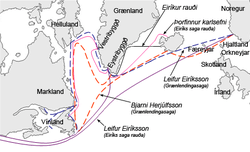Vinland sagas


The Vinland Sagas are two Icelandic texts written independently of each other in the early thirteenth century; The Saga of the Greenlanders (Grænlendinga Saga) and The Saga of Eric the Red, (Eiríks Saga Rauða). The sagas were written down between 1220 and 1280, much later than the initial time of action 970–1030.[1]
The Saga of Erik the Red and The Saga of the Greenlanders both contain different accounts of Norse voyages to Vinland. The name Vinland meaning "Wineland," is attributed to the discovery of grapevines upon the arrival of Leif Eiriksson in North America. The Vinland Sagas represent the most complete information we have about the Norse exploration of the Americas although due to Iceland's oral tradition, they cannot be deemed completely historically accurate and include contradictory details. However, historians commonly believe these sources contain substantial evidence of Viking exploration of North America through the descriptions of topography, natural resources and native culture. In comparing the events of both books, a realistic timeline can be created.[2][3]
The veracity of the Sagas was supported by the discovery and excavation of a Viking Era settlement at L'Anse aux Meadows in Newfoundland, Canada. Research done in the early 1960s by Norwegian explorer Helge Ingstad and his wife, archaeologist Anne Stine Ingstad, identified an old Norse settlement located at what is now the L'Anse aux Meadows National Historic Site of Canada.[4]
See also
References
- ↑ "Vikings: The North Atlantic Saga". Smithsonian Institution. Archived from the original on February 23, 2002. Retrieved October 18, 2015.
- ↑ "Vinland Sagas". Smithsonian Institution National Museum of Natural History. Retrieved October 18, 2015.
- ↑ Thayer Watkins. "The Vinland Sagas". San José State University. Economics Department. Retrieved October 18, 2015.
- ↑ "L'Anse aux Meadows National Historic Site of Canada". Parks Canada. Retrieved October 18, 2015.
Other Source
- Brown, Nancy Marie (2012) Song of the Vikings: Snorri and the Making of Norse Myths (Palgrave Macmillan) ISBN 978-0-230-33884-5
- Haugen, Einar (2007)Voyages To Vinland - The First American Saga Newly Translated And Interpreted (Barzun Press) ISBN 978-1-4067-7499-3
- Hreinsson, Vidar (1997) The Complete Sagas of Icelanders (Leifur Eiriksson Publishing, Reykjavik, Iceland) ISBN 978-9979-9293-0-7
Related Reading
- Grove, Jonathan. (2009) "The place of Greenland in medieval Icelandic saga narrative", in Norse Greenland: Selected Papers of the Hvalsey Conference 2008, Journal of the North Atlantic Special Volume 2, 30–51
- Jones, Gwyn (2001) A History of the Vikings (Oxford University Press) ISBN 978-0-19-280134-0
- Ingstad, Helge; Ingstad, Anne Stine (2001) The Viking Discovery of America: The Excavation of a Norse Settlement in L'Anse Aux Meadows, Newfoundland (Checkmark Books. New York) ISBN 0-8160-4716-2
- Magnusson, Magnus (1976)Viking, Hammer of the North (Putnam) Magnus Magnusson ISBN 978-0-399-11744-2
- Magnusson, Magnus (1979) Viking expansion westwards (Bodley Head archaeology Book Club Associates) ISBN 978-0-8098-3529-4